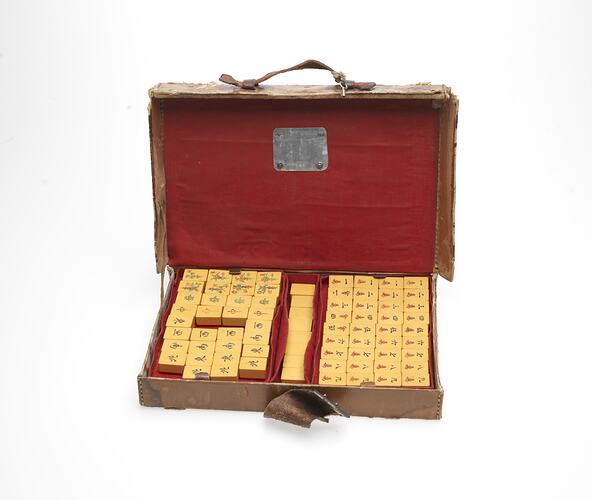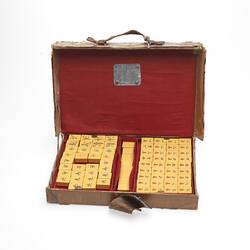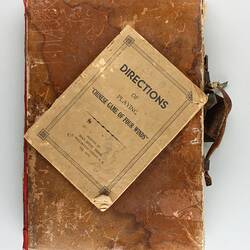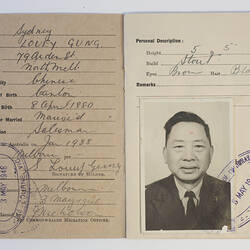Summary
Mahjong set which belonged to Sydney Louey Gung and Yun Ping and was brought to Australia by one of them when they migrated or during a return visit to China. Mahjong is a traditional and popular game originating in China which involves (allowing for some regional variations) the drawing and discarding of 144 tiles featuring Chinese characters and symbols until the legal hand is achieved. It is a game of skill, strategy and luck. The accompanying instruction booklet was printed in Hong Kong.
Sydney Louey Gung migrated to Australia from China in about 1900 at the age of 20 or 22 years. He married Yan Pein/ May Louey Gung in 1912 and they had seven children. Sydney spent most of his life in Melbourne, living in or around Carlton despite first arriving in Sydney. He worked as a cabinet maker and a fruit merchant for his older brother Harry Louey Pang as well as for the Geraldton Fruit Company. He died in 1954.
Physical Description
Case made from cardboard with a shellac like (varnish) surface finish. Leather handle and closure strap and metal clasp lock with a complete yellow and red plastic mahjong set inside with the instruction booklet. The interior of the case is lined with red cotton fabric and contains four trays, two on the bottom and two stacked on top, each containing 36 marked tiles. There is also a narrow central tay which holds four blank tiles, making a total of 148 tiles. The tiles are made from a phenol formaldehyde plastic which was introduced in 1907. Urea formaldehyde was introduced in 1937, placing the manufacturing period early 1907-1937. The inside of the lid has a plain metal plaque. The 23 page instruction booklet contains text in English and illustrations.
Significance
The Gung family collection provides an invaluable representation of Chinese migration and settlement experiences in the Museum's migration collections. The family narrrative spans two generations, enabling the exploration of key themes such as the establishment and gradual dillution of the White Australia policy, Chinese businesses and the labour market, and family life. Many of the documents in the collection reflect the gradual easing of the restrictions on Asian immigration which occurred in the 1950s and 1960s, policy shifts which contributed to the Racial Discrimination Act of 1975. The objects compliment the photographs and documents and tell the story of a family's desire to continue their cultural practices and remember their cultural heritage while living in Australia from the 1920s to the 1960s.
More Information
-
Collecting Areas
-
Acquisition Information
Donation from Jeff Gung, 11 Feb 2013
-
Past Owner & User
-
Inscriptions
Booklet Front Cover: 'DIRECTIONS/OF/PLAYING/'CHINESE GAME OF FOUR WINDS'/PRINTED BY/MANSHING PRESS/29, WELLINGTON STREET, H.K./TEL.26772'
-
Classification
-
Category
-
Discipline
-
Type of item
-
Overall Dimensions - Closed
314 mm (Width), 235 mm (Depth), 40 mm (Height)
-
Keywords







